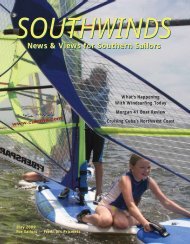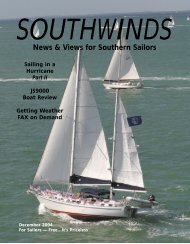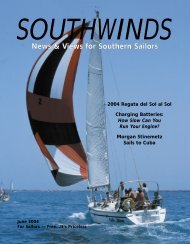Read PDF - Southwinds Magazine
Read PDF - Southwinds Magazine
Read PDF - Southwinds Magazine
You also want an ePaper? Increase the reach of your titles
YUMPU automatically turns print PDFs into web optimized ePapers that Google loves.
Types of Agents—or What’s<br />
Inside the Fire Extinguisher<br />
These are the agents you are<br />
most likely to find on your<br />
average pleasure boat:<br />
Dry chemicals. Can be used on<br />
A, B, and C fires. The label will<br />
indicate which. They are the<br />
most common type for small portable fire extinguishers<br />
found on most boats. All have a B, C rating, which is the<br />
minimum required by the USCG. Some are rated for A, B,<br />
and C, and this is preferred for marine use but not required.<br />
Dry chemicals work by cooling and smothering the fire with<br />
heavy smoke. The powder can be caustic, and if discharged,<br />
effort should be made to completely clean anything the<br />
powder has come in contact with.<br />
Clean agents. Called clean agents because they leave little<br />
or no residue after being discharged. The most common of<br />
these are CO2, Halon and now Halon substitutes. The<br />
Environmental Protection Agency has banned the use of<br />
Halon due to its CFCs. Halon is now being replaced with FE<br />
241, FE 200, HFC-227 and Halotron 1. Clean agents are not<br />
as common in small portable extinguishers as is dry chemical,<br />
but you can find some units that use it. They work by<br />
displacing oxygen in the air, thereby smothering the fire.<br />
The advantage is that they do not leave any residue. The<br />
disadvantage is that because they displace the oxygen, they<br />
are a suffocation hazard when used in confined spaces such<br />
as the cabin of a boat.<br />
Sizes of Extinguishers<br />
Sizes for portable fire extinguishers are set by the U.S. Coast<br />
Guard and use Roman numerals, I being the smallest and V<br />
being the largest. It’s rare to see anything bigger than a size<br />
II on the average-sized pleasure boat.<br />
Size I is 4 to 5 pounds clean agent and 2 to 3 pounds dry<br />
chemical. Commonly this size is not serviceable, meaning it<br />
cannot be recharged should it be used or lose its charge.<br />
Typical onboard B-1 fire extinguishers<br />
Check the label to see if it can<br />
be serviced or not. These are by<br />
far the most common size<br />
found on the average boat.<br />
Size II is 15 pounds clean agent<br />
and 10 pounds dry chemical.<br />
As these units are larger and<br />
more expensive, most (but not<br />
all) are serviceable. Once<br />
again—check your label. Serviceable units can be recharged<br />
by a certified fire extinguisher service center if they lose<br />
charge or are used.<br />
Extinguisher Requirements and Inspecting<br />
The U.S. Coast Guard by law requires all pleasure boats<br />
with engine compartments, and/or with permanently<br />
installed fuel tanks, to carry fire extinguishers. The minimum<br />
number and type are as follows:<br />
16-26 feet: One B-I<br />
26-40 feet: One B-II or two B-I. (Note: A fixed system<br />
equals one B-I.)<br />
40-65 feet: One B-II and one B-I or three B-I. (Note: A<br />
fixed system equals one B-I or two B-II.)<br />
The “B-I” and “B-II” are USCG designations for fire extinguisher<br />
types and sizes. The “B” is based on a complicated<br />
system set up by the USCG and the “I” and “II” are for the<br />
size. Suffice to say, always check the label to make sure it is<br />
USCG-approved. At minimum it should be for B, C fires<br />
with A, B, C preferred.<br />
All extinguishers should be professionally inspected<br />
and tagged at least once a year and a quick visual inspection<br />
done monthly. However, for pleasure boats this is a recommendation<br />
and not a requirement. More often than not, I<br />
find that most boaters rarely do either of these. The USCG<br />
requires you have onboard “approved” fire extinguishers.<br />
This leaves it up to the boat owner to maintain their equipment<br />
in good working order. If you are boarded by the<br />
USCG or local waterway officers, and you have fire extinguishers<br />
that are not fully charged, or are old and in poor<br />
Specializing in Marine SSB<br />
Sailmail / AirMail / Winlink<br />
sailmail@docksideradio.com<br />
www.docksideradio.com<br />
Ph: 941.661.4498<br />
Radios & Modems in Stock<br />
— Authorized Icom Dealer —<br />
— Pactor-III Modem Sales —<br />
FCC Marine Radio Licenses<br />
SSB/SailMail Training<br />
SSB Installation<br />
Troubleshooting<br />
Gary Jensen<br />
Owner/FCC Licensed Technician<br />
News & Views for Southern Sailors SOUTHWINDS September 2010 41

















